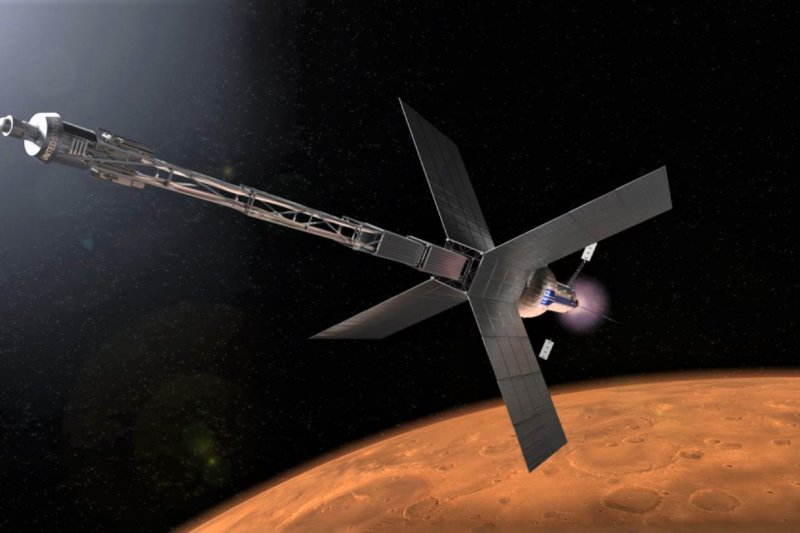FROM SPACE RACE TO SPACE WARS
U.S. needs nuclear spacecraft to compete with China, NASA official says
An illustration depicts a nuclear-powered, crewed Mars spacecraft. Image courtesy of NASA
ORLANDO, Fla., Oct. 20 (UPI) -- NASA and U.S. aerospace experts urged Congress on Wednesday to invest more quickly and heavily in development of nuclear-powered spacecraft Wednesday to stay ahead of such competitors as China.
The space agency believes spacecraft powered by a nuclear thermal rocket reach Mars in just three to four months, which is about half the time required by traditional, liquid propellant rockets.
"Strategic competitors including China are aggressively investing in a wide range of space technologies, including nuclear power and propulsion," Bhavya Lal, NASA's senior advisor for budget and finance, said during a congressional committee hearing Wednesday morning.
"The United States needs to move at a fast pace to stay competitive and to remain a leader in the global space community," Lal said.
The hearing occurred before the U.S. House of Representatives Science Space and Technology Committee. Experts delivered testimony even as reports emerged that China had tested an orbital rocket to deliver potential nuclear weapons at supersonic speeds.
China acknowledged it tested a spacecraft in August, but said it did not contain nuclear weapons.
The committee took no action as it gathered information for upcoming federal budget proposals.
"If the United States is serious about leading in a human mission to Mars, we have no time to lose," said U.S. Rep. Don Beyer, D-Va., who chairs the committee.
"Congress has prioritized development of nuclear space propulsion over the past several years, directing about $100 million annually for NASA to advance nuclear thermal propulsion capabilities with the goal of conducting a future in-space flight test," Beyer said.
NASA and the Department of Energy awarded $5 million to three companies in July to produce a nuclear-powered spacecraft reactor design. NASA officials said much more funding is needed, although agency officials didn't discuss dollar amounts Wednesday.
The key to developing such nuclear engines is to identify or develop materials that can withstand the heat and exposure involved, said Roger M. Myers, who chairs a committee on space nuclear engines for the National Academies of Sciences, Engineering and Medicine.
"The risks associated with [nuclear propulsion] are a fundamental materials challenge that we think is quite likely solvable," Myers testified during the hearing.
U.S. Rep. Ed Perlmutter, D-Colo., asked if any "fundamental scientific limitations" exist for a crewed Mars trip by 2033, or if it was just a matter of Congress appropriating the needed funds for technology development.
NASA can overcome challenges for a human mission to Mars given the resources, but the propulsion method for such a spacecraft is only one issue NASA much confront, Lal said.
"Deep space transport is just one piece of getting to Mars. ... We've landed small rovers there but a spacecraft carrying humans would be much bigger," Lal said. "We also need to make sure that the environmental control and life support systems can keep [astronauts] alive for two to three years."
Dispatches from Mars: Perseverance rover sends imagesNASA's Mars rover Perseverance captured images of Kodiak Butte, a rock outcrop in Jezero Crater that scientists said shows evidence of sediment and regular flood episodes from an ancient river and lake system. Photo courtesy of NASA


No comments:
Post a Comment